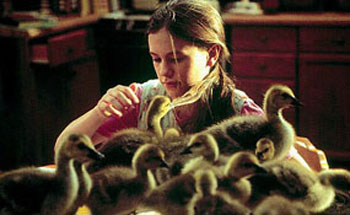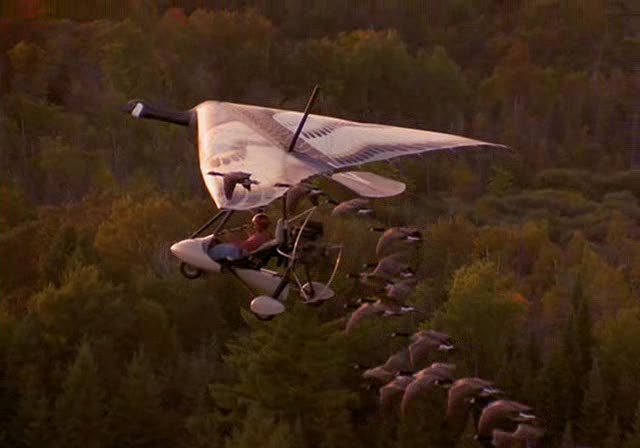
Fly Away Home focuses on 13-year-old Amy Alden who has just lost her mother due to a car accident. She has to move to her dad Tom, whom she hadn’t seen for years and whose passion for pottering aircrafts seems weird to her. Being alone, Amy finds a nest with 16 eggs, which have been abandoned due to felling of trees in the area. She takes them home and hides them, until a few days after 16 Canada geese hatch. They immediately perceive Amy as their mother and follow her everywhere. When the time for the birds arrives to migrate south, the birds get in danger of being confiscated. Tom’s brother David is able to find a national park in the US which is in danger of being turned into a development area in case no birds show up. Thus Amy and her dad train the birds to follow Amy in an ultralight aircraft to guide them on their 4-day-long journey to the US state of South Carolina, where people are happily waiting for them to finish their journey. The movie partly depicts the life of Bill Lishman whose idea to train birds to follow ultralight aircrafts gained great public and scientific attention5.
There is no doubt in listing the movie depicting Amy and Tom Alden’s journey on their ultralight aircrafts among the genre adventure. The inclusion of different dangers during their flight as well as the girl’s bravery2 are characteristic of this genre. However, the movie develops to depict different genres. Focusing on a 13-year-old girl in her teenage years who faces the task of raising up tiny chicks looking like “fuzz balls”1 opens up the potential to be a children’s movie2, i.e. a movie in which traumatized children befriend with wild animals through which they find healing4. The goslings, which similar to Amy are motherless, become the reference point among which Amy and her father Tom become able to reconcile and who enable Amy to cope with her grief and develop from a child into a teenage girl, thus depicting characteristics of a coming-of-age movie4. Additionally, the film moves beyond being a movie about human relationships by including documentary and wildlife events when portraying “pastoral green landscapes” and Amy’s “scientific fascination”2. Together with the main plot, guiding geese on their migration path, the movie presents a complete new way of protecting wildlife.
With the beginning of the movie, Amy, who is severely traumatized due to the loss of her mother, feels visibly uncomfortable in the relationship with her father. Based on their long separation and Tom being “unaccustomed to parenting”3, father and daughter move away from each other. The situation changes when Amy finds and rescues 16 Canada geese. Similar to her, the geese are motherless and just lost their home due to felling of trees. Thus, both Amy and the geese need to find a new “stable” and “secure” home4. This is when Tom finds a way to help Amy get over her grief and to establish a closer father-daughter relationship. By allowing Amy to keep the geese and to raise them, Tom and Amy become “reconciled in their concern for the well-fare of the geese”4. Very importantly, father, daughter and Susan, Tom’s new girlfriend, unite when being confronted with an enemy in form of an officer who wants to cut the geese’s wings to make them unable to fly3.
United in protecting the geese from any possible harm the movie takes a clear position about animal rights. Focusing on the family’s concern about the well-being of each individual goose, Fly Away Home presents us an animal rights perspective which focus on the individual well-being of animals rather than survival of the species or non-intervention in natural cycles4. This is especially evident when Igor, the goose which is handicapped, is the only individual whose process of finding a name is shown. Amy is shown to have a special interest in Igor even though or rather precisely because he is handicapped, thereby emphasizing Fly Away Home’s focus on individual animals. The officer of the local nature conservation agency counterparts this position when confronting the family with laws that tell them to have the geese pinioned. He thereby presents a position of law which does not focus on individual animal well-being but on preventing any harm caused by the animals on the farms and fields in the surrounding area. To pursue this aim the officer does not hesitate to hurt the animals and take away from them a crucial part of their animal lives – free flying4. With portraying Amy’s coming-of-age process, however, free flying is fundamental to the individual and related development of Amy and the geese. Amy’s reaction to the officers attempt to pinion the geese clearly shows that it has a strong impact on her. Her locking herself up into the bathroom suggests that the development she did so far is in danger. Amy might again fall back into old behavior patterns in which she wanted to be on her own separated from her father and Susan. This clearly shows the strong connection between the geese’s and Amy’s ability to fly – which for Amy means to become more mature and open. By the officer’s willingness to hurt the goslings he again contradicts Amy and her father’s position. Amy’s shocking action when realizing the officer was going to hurt one of the geese shows that her individual view on each of the goslings is based on the sense of pain, a basic ethic principle which by the ability to feel pain sees animals and human beings equal to each other4. Fly Away Home emphasizes this principle.

Amy is having breakfast together with the goslings which follow her round
Additionally, Amy’s own development is accelerated when finding and raising the geese. In difference to other animals, pets such as dogs or cats, Canada geese have certain characteristics helpful for Amy’s development. Firstly, Canada geese obviously belong to the class of non-domestic animals not being a pet or a farm animal. Thus they possess a wild character which helps Amy to turn away from childish habits and to become a teenager. One important step in this development is Halloween time. Amy, together with the guys who help Tom to build the ultralight aircrafts, prepares pumpkins and has a lot of fun. Additionally, Amy now has a piercing in her nose – truly a sign that she has turned into a teenager4. Secondly, it is an important characteristic of the geese that they similar to many other birds are able to fly. Not only their ability but their natural drive to fly encourages Amy to also “fly away”, metaphorically used to tell her to become more adult. Tom emphasizes this when telling Amy that she cannot keep the geese at home in their barn as this would be like a “jail”4 for them. Similar to the geese, Tom sees that he needs to let Amy have her freedom to develop into a self-confident and grown person. Both these characteristics of Canada geese, their wilderness and their desire to fly, immensely help Amy Alden to first overcome her grief and later on to develop into a young teenage girl.
Fly Away Home uses two different scenes to focus on both Canada geese’s behavior and their relationship to their “mother” Amy. In the opening scene of the geese-plot, the little goslings hatch and immediately imprint on Amy, the very first individual they see. David, Amy’s uncle, only some time later explains the viewer about the natural process of imprinting, which all geese do as soon as they hatch. The movie focuses on this process by portraying close ups of Amy’s face only and the little goslings in their struggle to break away from their eggshells. This technique allows the viewer to understand the close relationship which immediately develops between Amy and each individual gosling. The scene depicts them in a seemingly simple and innocent way, without any voice-over but only enjoying the immediacy of the very moment. Especially the goslings appear very “sweet and charming”4 during this process of peaceful and loving imprinting between “mother Amy” and her “children”.

Amy in her ultralight aircraft is followed by her 15 Canada geese; Igor, the handicapped goose, sits next to her on the aircraft.
The climax scene of the geese’s development is their very first flight following Amy in Tom’s ultralight aircraft. After Tom has emphasized the immediate need for the geese to fly to not only follow their natural drive but also to escape the danger of being confiscated by the local nature conservation agency, Amy desperately tries to make her geese fly by taking her dad’s aircraft on her own without permission. Luckily, the geese follow their natural behavior by following their mother Amy and by starting to fly for the first time. Although Amy’s flight ends with a crash landing, all persons involved feel great relief when seeing that the geese although being raised by a human will follow their mother Amy in an ultralight aircraft. Due to this, Tom and Amy will be able to make the geese migrate south when they just follow her flying the ultralight aircraft.
Fly Away Home presents certain characteristics, which represent different genres. Most important, however, the movie focuses on the healing of its traumatized main character Amy Alden, which she finds in her relationship to Canada geese. Very famous movies, such as Free Willy (1993) or Flipper (1996), also focus on this development4. Each of these movies focuses on a child which has experienced an event that changed their lives leaving them traumatized – often the breakdown of their families4. In their relationship with wild animals, such as black fish (Free Willy 1993), dolphin (Flipper 1996) or Canada geese (Fly Away Home 1996) these children experience healing4. Importantly, the animals chosen are commonly known for their travelling far distances around the world which symbolizes a strong sense of freedom. Nevertheless, for the movies, it is an important characteristic that they are either caged or tied to their strong connection with humans. Both the human main characters and their animal friends thus need to break away from some form of restriction which they experience within their relationships.
Sources and further readings:
1 Brussat, Frederic and Mary Ann. “Fly Away Home.” Spirituality & Practice: Resources for Spiritual Journeys. n.d. Web. 28.12.2015
2 Ebert, Roger. “FlyAway Home.” Roger Ebert. 1996. Web. 31.12.2015
3 Grant, Caroline M. “Fly Away Home.” Literary Mama: Writing about the many faces of motherhood. 2009. Web. 13.12.2015
4 Ingram, David. “Fly Away Home and the Hollywood Conservationist Movie.” ScopeO: An Online Journal of Film Studies. December2000. Web. 28.12.2015
5 Harris, Sarah and Bill Lishman. “For the Birds: An Interview with Bill Lishman.” Cabinet Issue 11. Cabinet Magazine, 2003. Web. 28.12.2015
„Amy und die Wildgänse.“ Imdb Filmbase. Web. 28.12.2015
Maslin, Janet. “Fly Away Home (1996) – Make Way for Goslings.” The New York Times. 1996. Web. 13.12.2015